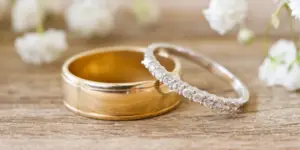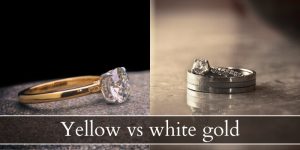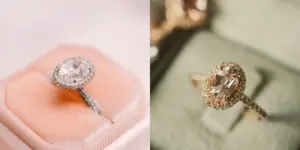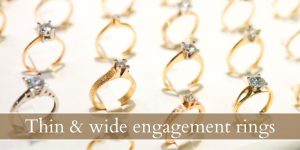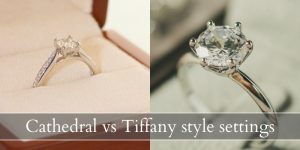Bezel and prong settings are two completely opposite styles of setting a gem into metal. Whether it’s a ring, pendant, earring, or bracelet, these two settings offer a very different way to hold the diamond in place.
Both are great in their own way, but which is right for your particular diamond ? Let’s take a look at the main differences between bezel and prong settings, see how they both work, and finally decide which is best for your diamond.
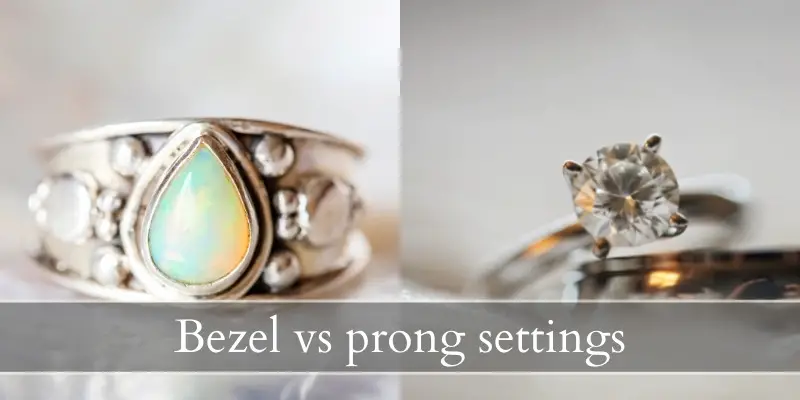
Bezel vs prong setting
A bezel setting is much more secure than a prong setting, but allows far less light into the diamond. This means a bezel setting will sparkle less than a prong setting, but it will not snag on clothes and hair. A bezel setting is also more expensive than a prong setting, as it means more metal is worked around the diamond and the jeweler needs a higher skill for this. Finally, prong settings are very risky for softer stones, while bezel settings can be applied to any gem or mineral you want to wear.
What is a bezel setting ?
A bezel setting is a band of metal that completely surrounds the side of the gemstone. In a traditional round brilliant cut the band hugs the girdle of the diamond and goes a little onto the crown. This ‘belt’ is then welded onto the ring shank.
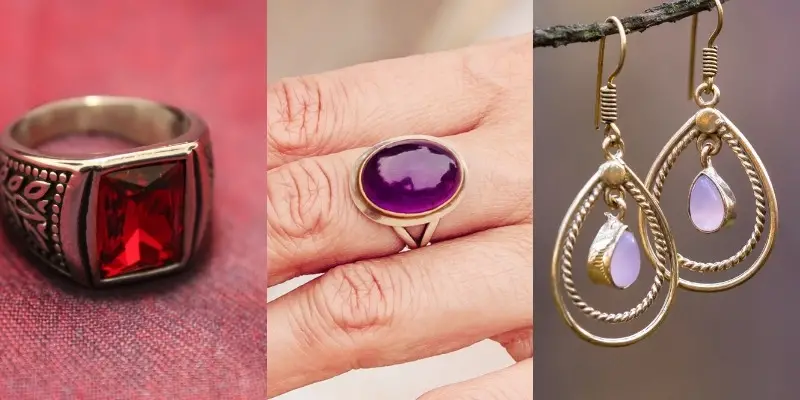
The bezel can be complete (top-bottom) or it can be just a narrow band that is then held up by prongs. Really, a bezel set is about the way the most exposed side of a gem is protected. The sharpest points – like the girdle and culet – are weak points where the gem can chip. So covering that with a metal band is providing extra safety and keeping the gem very tightly in place.
What is a prong setting ?
A prong setting is a set of prongs (4 to 6) that extend from the ring shank, flush against the pavilion of the gem, and hold onto the gem girdle. It’s one of the most common gem settings and it works very well for diamonds, sapphires, morganite, and other strong gems.

Sometimes the prongs sit atop the ring shank in a thin point, like in a Tiffany setting, and sometimes they taper onto the shank, like a cathedral setting. The whole idea of a prong setting is to raise the diamond onto the band and allow more light to travel through it.
Both bezel and prong settings have their pros and cons, so let’s compare the two.
1. Bezel settings are more secure than prong settings
If you’re aiming for gem security, making sure the diamond doesn’t budge and will be set there until the end of time, then a bezel setting is a great choice. This is the most protective of all gem settings, as there isn’t much of the diamond exposed, and the bezel itself will take most of the hits in case of small accidents.
Prong settings by their nature may loosen and get weaker in time. After all, they are thin bands of metal, and they can be bent out of shape. You may try to get a metal that is sturdier, like platinum, but it will also cost much more. We’re not saying all prong settings lose their stones, we’re simply saying there is a higher chance of losing a gem from a prong than from a bezel setting.
2. Prong settings allow more light into the stone
Prong settings do let your diamond shine brightly and showcase its brilliance. This is because a diamond, like most gemstones, relies one outside light to sparkle. This means that light entering the diamond from the side and bottom will also bring some more brilliance. This is the overall effect of a prong setting and it’s no wonder it’s the most popular way to set a diamond into a ring.
A bezel setting does not allow this much brilliance, because about 70% of the diamond is covered. In fact, the only part that is uncovered is the table and crown (the top parts). So a diamond set in a bezel will not receive as much light and thus not sparkle as well.
There are bezel settings that do not extend all the way down, and instead leave the bottom of the diamond a bit exposed. Those may sparkle more, but never more than a prong setting because the girdle (a key focal point) is shadowed.
3. Bezel settings work for nearly all gems, prongs do not
If you’re not sure what kind of gemstones you’re going to set in that engagement ring, then a bezel setting may be a better option. All gemstones have varying levels of hardness, which dictates how easily they chip and scratch. This is measured on the Mohs scale of hardness.
A diamond has a hardness of 10, the highest score on that scale. An amethyst is 7.5, much softer and may chip. Pearls, while beautiful, are a 3 on the same scale and a really bad idea for a daily wear ring. They can chip, split, and completely break if handled without enough care.
But, a prong setting will ensure that all the most vulnerable sides of your favored gemstones are covered. Does this mean they will never break ? No. But it means they have a higher chance of surviving a night out unscathed. You can further up these chances by opting for a cabochon cut for the very soft ones, like lapis lazuli, jade, or coral.
A prong setting exposes all the sides of your gemstone, so you better have a strong one on hand. Any gemstone over 8 on the Mohs scale should survive just fine. Though the higher the score, the smaller than chances of your gem chipping, regardless of its setting.
Read also: Gem Settings Explained
4. Prong settings may snag, bezel settings sit low
Because prong settings reach onto the crown of a gemstone a bit, they can snag on clothes or hair or anything that is a bit loose. Sweaters and cardigans are notorious diamond snatchers. This doesn’t mean a prong setting will always snag and ruin something, but it has a higher chance of doing so.
Meanwhile bezel settings are sleek and smooth, so they just glide over materials and textures like it’s not problem.
5. Bezel settings may look bulky and limit design choices
A bezel setting does not look as delicate or dainty as a prong setting, and this show in the design options you have left. While a prong setting can be incorporated into nearly any design, a bezel setting works differently. It surrounds the sides of the gem with more metal, making it wider but not in the best way. In some unfortunate cases a bezel setting can look like a short tube extending from a ring. In some cases it can look decent but you have to look at a few options.
So if you’re going for a girly, delicate ring a bezel setting will be difficult to pair with this. But if you opt for a halo around that bezel you might just make it work.
By contrast a prong setting will be delicate by itself, so it will look great on any design.
6. Prong settings are more affordable, are flexible
In case you already have the diamond with you and just need to get a pre-made setting, a prong works better. It is more flexible and can be shaped easier to the gem’s specific size and weight.
A bezel setting needs to be done from scratch, or used for some very specific gem shapes and carat sizes. They are difficult to tweak and it’s much better to get the gem and then ask the jeweler to design a bezel setting for that gem in particular. It’s less of a hassle and just as expensive as getting a pre-made bezel setting that may not work.
In either case, bezel or prong setting, we heavily discourage you from buying pre-made settings and then looking for a stone that fits. You run a high chance of not finding the right size stone and getting a poor quality setting. Best to get the stone you want, and then talk to your jeweler so you can design together something you like.

I’m the main author for jewelrymaterialguide.com. I started this site after we did tons of research before our wedding and noticed that there is information about rings, jewelry, and so on that is really hard to find on the internet.

